Boqi Chen
WeChat-YATT: A Simple, Scalable and Balanced RLHF Trainer
Aug 11, 2025Abstract:Reinforcement Learning from Human Feedback (RLHF) has emerged as a prominent paradigm for training large language models and multimodal systems. Despite notable advances enabled by existing RLHF training frameworks, significant challenges remain in scaling to complex multimodal workflows and adapting to dynamic workloads. In particular, current systems often encounter limitations related to controller scalability when managing large models, as well as inefficiencies in orchestrating intricate RLHF pipelines, especially in scenarios that require dynamic sampling and resource allocation. In this paper, we introduce WeChat-YATT (Yet Another Transformer Trainer in WeChat), a simple, scalable, and balanced RLHF training framework specifically designed to address these challenges. WeChat-YATT features a parallel controller programming model that enables flexible and efficient orchestration of complex RLHF workflows, effectively mitigating the bottlenecks associated with centralized controller architectures and facilitating scalability in large-scale data scenarios. In addition, we propose a dynamic placement schema that adaptively partitions computational resources and schedules workloads, thereby significantly reducing hardware idle time and improving GPU utilization under variable training conditions. We evaluate WeChat-YATT across a range of experimental scenarios, demonstrating that it achieves substantial improvements in throughput compared to state-of-the-art RLHF training frameworks. Furthermore, WeChat-YATT has been successfully deployed to train models supporting WeChat product features for a large-scale user base, underscoring its effectiveness and robustness in real-world applications.
Accurate and Consistent Graph Model Generation from Text with Large Language Models
Aug 01, 2025Abstract:Graph model generation from natural language description is an important task with many applications in software engineering. With the rise of large language models (LLMs), there is a growing interest in using LLMs for graph model generation. Nevertheless, LLM-based graph model generation typically produces partially correct models that suffer from three main issues: (1) syntax violations: the generated model may not adhere to the syntax defined by its metamodel, (2) constraint inconsistencies: the structure of the model might not conform to some domain-specific constraints, and (3) inaccuracy: due to the inherent uncertainty in LLMs, the models can include inaccurate, hallucinated elements. While the first issue is often addressed through techniques such as constraint decoding or filtering, the latter two remain largely unaddressed. Motivated by recent self-consistency approaches in LLMs, we propose a novel abstraction-concretization framework that enhances the consistency and quality of generated graph models by considering multiple outputs from an LLM. Our approach first constructs a probabilistic partial model that aggregates all candidate outputs and then refines this partial model into the most appropriate concrete model that satisfies all constraints. We evaluate our framework on several popular open-source and closed-source LLMs using diverse datasets for model generation tasks. The results demonstrate that our approach significantly improves both the consistency and quality of the generated graph models.
NOCTA: Non-Greedy Objective Cost-Tradeoff Acquisition for Longitudinal Data
Jul 16, 2025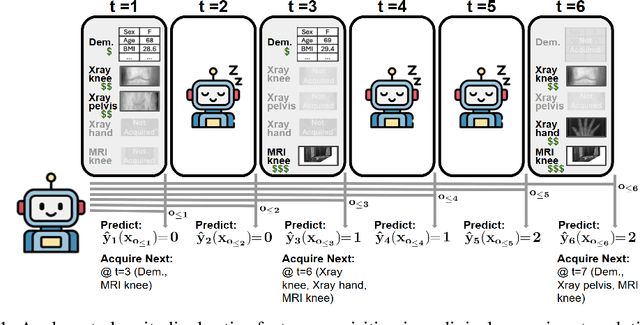


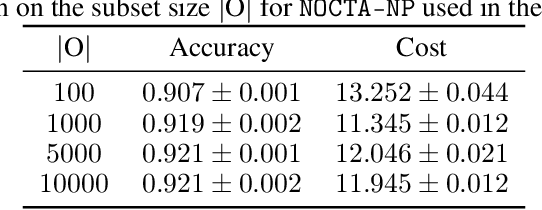
Abstract:In many critical applications, resource constraints limit the amount of information that can be gathered to make predictions. For example, in healthcare, patient data often spans diverse features ranging from lab tests to imaging studies. Each feature may carry different information and must be acquired at a respective cost of time, money, or risk to the patient. Moreover, temporal prediction tasks, where both instance features and labels evolve over time, introduce additional complexity in deciding when or what information is important. In this work, we propose NOCTA, a Non-Greedy Objective Cost-Tradeoff Acquisition method that sequentially acquires the most informative features at inference time while accounting for both temporal dynamics and acquisition cost. We first introduce a cohesive estimation target for our NOCTA setting, and then develop two complementary estimators: 1) a non-parametric method based on nearest neighbors to guide the acquisition (NOCTA-NP), and 2) a parametric method that directly predicts the utility of potential acquisitions (NOCTA-P). Experiments on synthetic and real-world medical datasets demonstrate that both NOCTA variants outperform existing baselines.
Revisiting Automatic Data Curation for Vision Foundation Models in Digital Pathology
Mar 24, 2025Abstract:Vision foundation models (FMs) are accelerating the development of digital pathology algorithms and transforming biomedical research. These models learn, in a self-supervised manner, to represent histological features in highly heterogeneous tiles extracted from whole-slide images (WSIs) of real-world patient samples. The performance of these FMs is significantly influenced by the size, diversity, and balance of the pre-training data. However, data selection has been primarily guided by expert knowledge at the WSI level, focusing on factors such as disease classification and tissue types, while largely overlooking the granular details available at the tile level. In this paper, we investigate the potential of unsupervised automatic data curation at the tile-level, taking into account 350 million tiles. Specifically, we apply hierarchical clustering trees to pre-extracted tile embeddings, allowing us to sample balanced datasets uniformly across the embedding space of the pretrained FM. We further identify these datasets are subject to a trade-off between size and balance, potentially compromising the quality of representations learned by FMs, and propose tailored batch sampling strategies to mitigate this effect. We demonstrate the effectiveness of our method through improved performance on a diverse range of clinically relevant downstream tasks.
Downstream Analysis of Foundational Medical Vision Models for Disease Progression
Mar 21, 2025

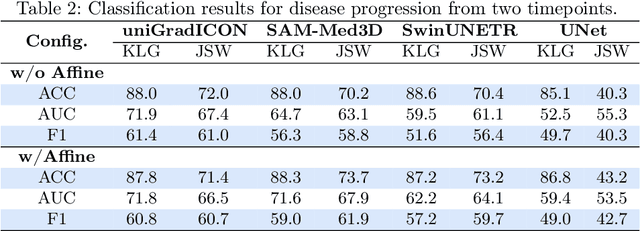
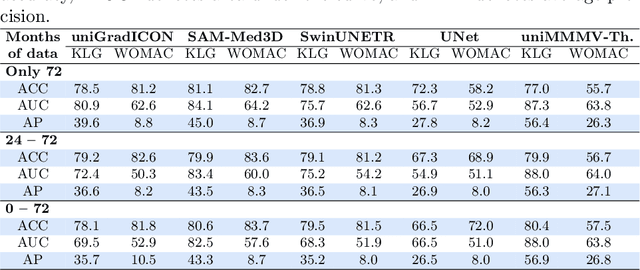
Abstract:Medical vision foundational models are used for a wide variety of tasks, including medical image segmentation and registration. This work evaluates the ability of these models to predict disease progression using a simple linear probe. We hypothesize that intermediate layer features of segmentation models capture structural information, while those of registration models encode knowledge of change over time. Beyond demonstrating that these features are useful for disease progression prediction, we also show that registration model features do not require spatially aligned input images. However, for segmentation models, spatial alignment is essential for optimal performance. Our findings highlight the importance of spatial alignment and the utility of foundation model features for image registration.
MIXPINN: Mixed-Material Simulations by Physics-Informed Neural Network
Mar 17, 2025Abstract:Simulating the complex interactions between soft tissues and rigid anatomy is critical for applications in surgical training, planning, and robotic-assisted interventions. Traditional Finite Element Method (FEM)-based simulations, while accurate, are computationally expensive and impractical for real-time scenarios. Learning-based approaches have shown promise in accelerating predictions but have fallen short in modeling soft-rigid interactions effectively. We introduce MIXPINN, a physics-informed Graph Neural Network (GNN) framework for mixed-material simulations, explicitly capturing soft-rigid interactions using graph-based augmentations. Our approach integrates Virtual Nodes (VNs) and Virtual Edges (VEs) to enhance rigid body constraint satisfaction while preserving computational efficiency. By leveraging a graph-based representation of biomechanical structures, MIXPINN learns high-fidelity deformations from FEM-generated data and achieves real-time inference with sub-millimeter accuracy. We validate our method in a realistic clinical scenario, demonstrating superior performance compared to baseline GNN models and traditional FEM methods. Our results show that MIXPINN reduces computational cost by an order of magnitude while maintaining high physical accuracy, making it a viable solution for real-time surgical simulation and robotic-assisted procedures.
The Power of Types: Exploring the Impact of Type Checking on Neural Bug Detection in Dynamically Typed Languages
Nov 22, 2024



Abstract:Motivation: Automated bug detection in dynamically typed languages such as Python is essential for maintaining code quality. The lack of mandatory type annotations in such languages can lead to errors that are challenging to identify early with traditional static analysis tools. Recent progress in deep neural networks has led to increased use of neural bug detectors. In statically typed languages, a type checker is integrated into the compiler and thus taken into consideration when the neural bug detector is designed for these languages. Problem: However, prior studies overlook this aspect during the training and testing of neural bug detectors for dynamically typed languages. When an optional type checker is used, assessing existing neural bug detectors on bugs easily detectable by type checkers may impact their performance estimation. Moreover, including these bugs in the training set of neural bug detectors can shift their detection focus toward the wrong type of bugs. Contribution: We explore the impact of type checking on various neural bug detectors for variable misuse bugs, a common type targeted by neural bug detectors. Existing synthetic and real-world datasets are type-checked to evaluate the prevalence of type-related bugs. Then, we investigate how type-related bugs influence the training and testing of the neural bug detectors. Findings: Our findings indicate that existing bug detection datasets contain a significant proportion of type-related bugs. Building on this insight, we discover integrating the neural bug detector with a type checker can be beneficial, especially when the code is annotated with types. Further investigation reveals neural bug detectors perform better on type-related bugs than other bugs. Moreover, removing type-related bugs from the training data helps improve neural bug detectors' ability to identify bugs beyond the scope of type checkers.
Generalizable Single-Source Cross-modality Medical Image Segmentation via Invariant Causal Mechanisms
Nov 07, 2024Abstract:Single-source domain generalization (SDG) aims to learn a model from a single source domain that can generalize well on unseen target domains. This is an important task in computer vision, particularly relevant to medical imaging where domain shifts are common. In this work, we consider a challenging yet practical setting: SDG for cross-modality medical image segmentation. We combine causality-inspired theoretical insights on learning domain-invariant representations with recent advancements in diffusion-based augmentation to improve generalization across diverse imaging modalities. Guided by the ``intervention-augmentation equivariant'' principle, we use controlled diffusion models (DMs) to simulate diverse imaging styles while preserving the content, leveraging rich generative priors in large-scale pretrained DMs to comprehensively perturb the multidimensional style variable. Extensive experiments on challenging cross-modality segmentation tasks demonstrate that our approach consistently outperforms state-of-the-art SDG methods across three distinct anatomies and imaging modalities. The source code is available at \href{https://github.com/ratschlab/ICMSeg}{https://github.com/ratschlab/ICMSeg}.
Detecting Frames in News Headlines and Lead Images in U.S. Gun Violence Coverage
Jun 25, 2024
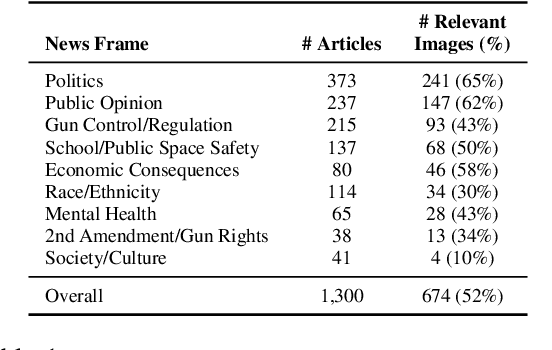
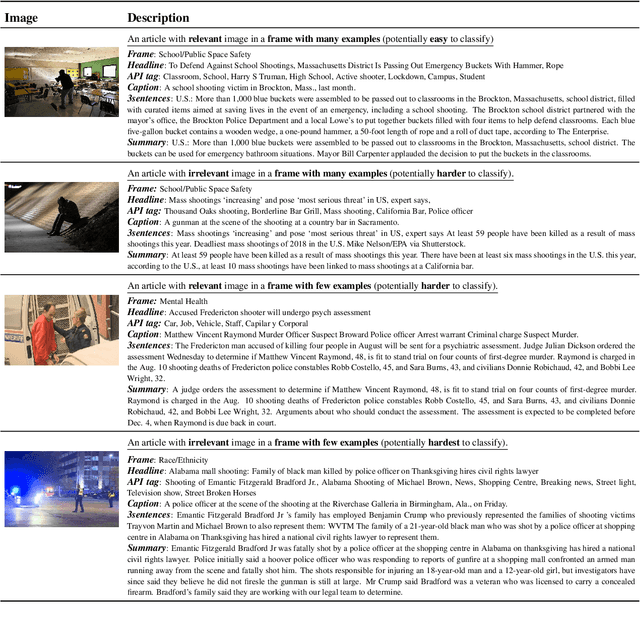
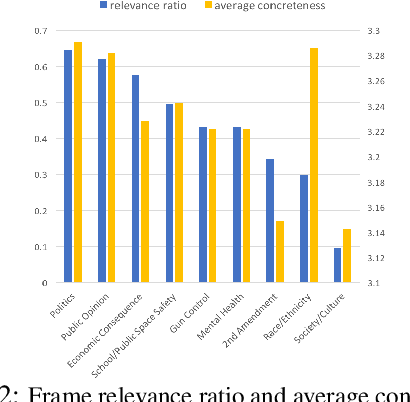
Abstract:News media structure their reporting of events or issues using certain perspectives. When describing an incident involving gun violence, for example, some journalists may focus on mental health or gun regulation, while others may emphasize the discussion of gun rights. Such perspectives are called \say{frames} in communication research. We study, for the first time, the value of combining lead images and their contextual information with text to identify the frame of a given news article. We observe that using multiple modes of information(article- and image-derived features) improves prediction of news frames over any single mode of information when the images are relevant to the frames of the headlines. We also observe that frame image relevance is related to the ease of conveying frames via images, which we call frame concreteness. Additionally, we release the first multimodal news framing dataset related to gun violence in the U.S., curated and annotated by communication researchers. The dataset will allow researchers to further examine the use of multiple information modalities for studying media framing.
Certifying Robustness of Graph Convolutional Networks for Node Perturbation with Polyhedra Abstract Interpretation
May 14, 2024



Abstract:Graph convolutional neural networks (GCNs) are powerful tools for learning graph-based knowledge representations from training data. However, they are vulnerable to small perturbations in the input graph, which makes them susceptible to input faults or adversarial attacks. This poses a significant problem for GCNs intended to be used in critical applications, which need to provide certifiably robust services even in the presence of adversarial perturbations. We propose an improved GCN robustness certification technique for node classification in the presence of node feature perturbations. We introduce a novel polyhedra-based abstract interpretation approach to tackle specific challenges of graph data and provide tight upper and lower bounds for the robustness of the GCN. Experiments show that our approach simultaneously improves the tightness of robustness bounds as well as the runtime performance of certification. Moreover, our method can be used during training to further improve the robustness of GCNs.
 Add to Chrome
Add to Chrome Add to Firefox
Add to Firefox Add to Edge
Add to Edge